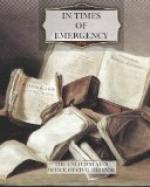A shelter can be the basement or inner corridor of any large building; the basement of a private home; a subway or tunnel; or even a backyard trench with some kind of shielding material (heavy lumber, earth, bricks, etc.) serving as a roof.
In addition to protecting people from fallout radiation, most fallout shelters also would provide some limited protection against the blast and heat effects of nuclear explosions that were not close by.
Chapter 4 (pages 23-32) discusses the various types of fallout shelters that people can use to protect themselves in case of nuclear attack.
FOOD AND WATER WOULD BE AVAILABLE AND USABLE
From many studies, the Federal Government has determined that enough food and water would be available after an attack to sustain our surviving citizens. However, temporary food shortages might occur in some areas, until food was shipped there from other areas.
Most of the Nation’s remaining food supplies would be usable after an attack. Since radiation passing through food does not contaminate it, the only danger would be the actual swallowing of fallout particles that happened to be on the food itself (or on the can or package containing the food), and these could be wiped or washed off. Reaping, threshing, canning and other processing would prevent any dangerous quantities of fallout particles from getting into processed foods. If necessary to further protect the population, special precautions would be taken by food processors.
Water systems might be affected somewhat by radioactive fallout, but the risk would be small, especially if a few simple precautions were taken. Water stored in covered containers and water in covered wells would not be contaminated after an attack, because the fallout particles could not get into the water. Even if the containers were not covered (such as buckets or bathtubs filled with emergency supplies of water), as long as they were indoors it is highly unlikely that fallout particles would get into them.
Practically all of the particles that dropped into open reservoirs, lakes, and streams (or into open containers or wells) would settle to the bottom. Any that didn’t would be removed when the water was filtered before being pumped to consumers. A small amount of radioactive material might dissolve in the water, but at most this would be of concern for only a few weeks.
Milk contamination from fallout is not expected to be a serious problem after an attack. If cows graze on contaminated pasture and swallow fallout particles that contain some radioactive elements, their milk might be harmful to the thyroid glands of infants and small children. Therefore, if possible, they should be given canned or powdered milk for a few weeks if authorities say the regular milk supply is contaminated by radioactive elements.
In summary, the danger of people receiving harmful doses of fallout radiation through food, water or milk is very small. People suffering from extreme hunger or thirst should not be denied these necessities after an attack, even if the only available supplies might contain fallout particles or other radioactive substances.




